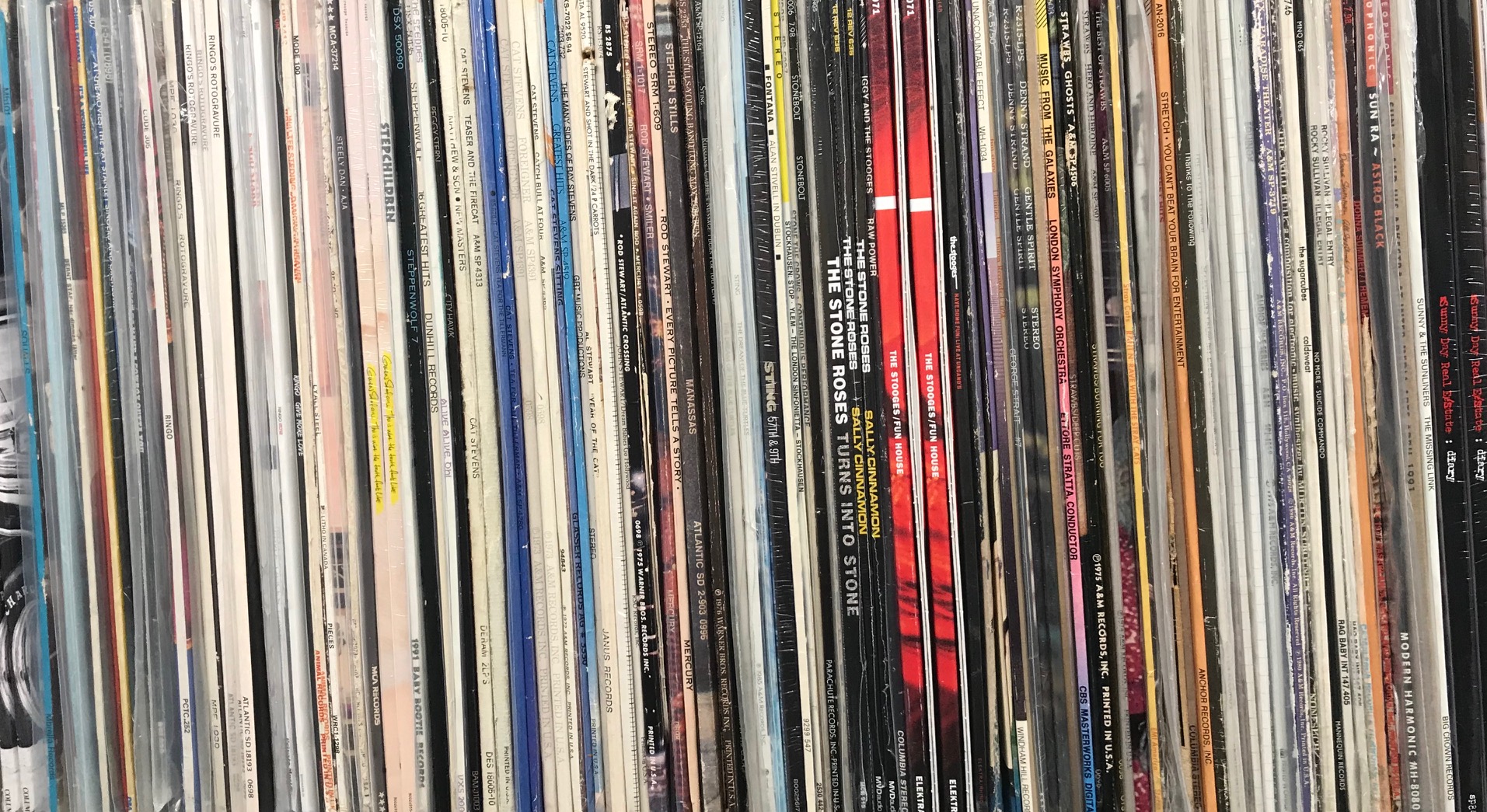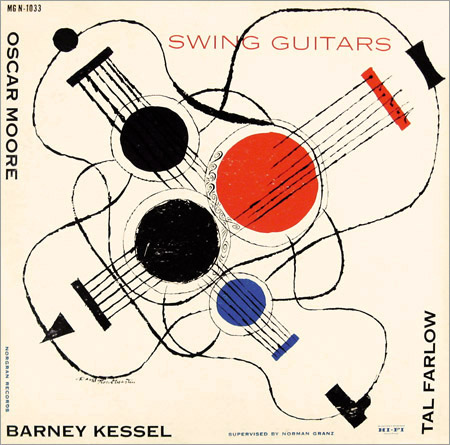THE OUTRAGEOUS STORY OF THE BEATLES’ BUTCHER COVER
THE STORY OF THE MOST CONTROVERSIAL COVER IN ROCK N ROLL HISTORY !!!
Hi Everybody, Welcome to Vinylvana’s FIRST BLOG!!!
I’m Kevin, and today I’m going to tell you about one of the most outrageous covers in Rock n Roll History. The fact that this cover comes from, arguably, the greatest band in Rock n Roll history, THE BEATLES, makes it all the more infamous.
Let’s dive into the story of the Beatles’ ”Yesterday & Today” album OR as many collectors like to call it, “The BUTCHER Cover”!!!
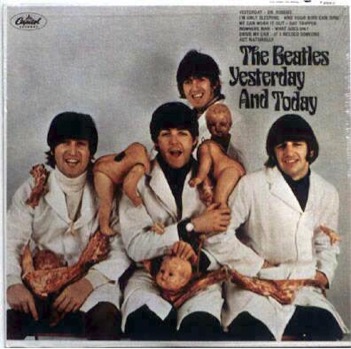
As you can see, the Beatles’ album “Yesterday & Today” was first issued in June of 1966 with this amazing, some would call grotesque, LP Cover image. It quickly earned the name, “The Butcher Cover” as the band members are all wearing white butcher jackets. The photo is adorned with pieces of raw meat placed all around the band along with plastic baby doll heads, torsos and limbs. All the while, John, Paul, George & Ringo are posing for a group picture with these crazy smiles on their faces. It was a total shocker of a cover.
When I was a kid, back in 1966, the same year that this LP, “Yesterday & Today” was released, I saw my elder sister dancing with glee on her bed to “Paperback Writer” (one of my earliest memories). That may have been my start to a lifelong interest in the Beatles. I’ve been an avid collector of them and other music since the late ’70’s. During that time, I got the book “The Beatles: An Illustrated Record”, by Roy Carr & Tony Tyler. Amongst those pages, I saw, for the first time, the photo of the Butcher cover. I was truly shocked. This LP had to be on my bucket list.
Why on Earth would the Beatle’s label, Capitol Records, put this out? Well, I believe, the answer is simple…money!
Let’s look at the history behind the Butcher Cover.
IT WAS 1966!
The Beatles had been a cash cow for their American label, Capitol Records for 2 solid years. During 1964, Capitol released 5 Beatles LP’s…in 1965, they issued 4 Beatle titles. But by early in 1966, the Beatle’s output had slowed due to the band’s touring and the band’s increasing interest in taking more time in the studio to flex their incredible creativity!
This left Capitol Records eager to put out another Beatles’ product. The band’s next release, “Revolver” was months away from being ready so Capitol made the decision to assemble a compilation album with songs from the Beatle’s UK albums “Help”, “Rubber Soul”, and some assorted UK singles. In addition, they got the Beatles to send them 3 songs from, at that time, their upcoming August release, “Revolver”. Capitol’s new compilation, set for June release, was to be titled, “Yesterday & Today”.
Capitol Records had a rich tradition of making compilations like this. Early on, they realized that they could put out more albums if they just used fewer songs. Capitol’s Beatle LP’s had around 11-12 songs while their UK counterparts, the Beatles LPs on Parlophone Records, would have 14 songs per LP. In addition, Parlophone would rarely put single releases on their albums. Songs like “I Want To Hold Your Hand” and “She Loves You” were both UK singles and never appeared on a UK album (until 1969). But in America, those songs showed up on “Meet The Beatles” and “The Beatle’s Second Album”.
This editing by Capitol resulted in their issuing more Beatle’s albums in America than in England. Albums like “Beatles VI”, “Beatle’s 65” and “The Beatles Second Album” were all albums created by Capitol that originated in the United States only and not in the UK. They were simply compilations with songs taken from existing UK albums and singles.
So by March of 1966, Capitol had readied the next great Beatles LP compilation, “Yesterday & Today”, and they just needed a new cover photo. Needless to say, the Beatles were not exited to do another photo session for Capitol but they did have some interesting artistic photos that they had taken days before with photographer Robert Whitaker.
At that photo session, Whitaker had challenged the Beatles to do something more provocative. Whitaker described the theme of the session as “A Somnambulist Adventure”. “Somnambulist” being a term that means “sleepwalking”. The session, in Whitaker’s eyes, was meant to mix images of birth, life and death, in a surreal fashion, and the Butcher scene was just one of many ideas that was acted upon that day. The session was also meant to put the image of the Beatles as the happy go lucky mop tops, off it’s head, literally! Brian Epstein, the Beatle’s manager and Tony Barrow, their publicist, attended the session and, besides being amused, both thought the images would never be released….
On the contrary!
What shocks me to this day is the fact that Capitol Records actually approved the Butcher image, manufactured the covers and released it to their distributors, reviewers and to disc jockeys. OUTRAGEOUS!!!
There were attempts made by Capitol to request a different cover. The president of Capitol Records, Alan Livingston, phoned Brian Epstein up and said that he was getting feedback from his distributors that they wouldn’t be able to sell the record as is. But the Beatles, by contract, had the final say on the cover image and only agreed to let Capitol air-brush out some of the blood. As a concession to the band and to his customers, Livingston said they would only manufacture a small amount of LPs, like a hundred or so, for review by their distributors, their sales force and to disc jockeys and reviewers.
Here’s what I would call the unbelievable part….This order, from the Capitol president Alan Livingston, went unheeded. Instead, the production department at Capitol prepared 750,000 copies and shipped them to their distributors! And their reaction?
THEY HATED IT! How could they sell it? How could DJ’s rationalize, to their listeners, the Beatle’s bad taste? Where did our happy mop tops go?
So Capitol Records made the decision to recall every copy of the record, all 750,000 copies, in an operation that Capitol named, “OPERATION RETRIEVE”. Every copy was recalled from their distributors a day before the LP’s release date. Despite that, a few leaked out to the public. One distributor, which owned its own record stores, pre-released the LP a day early and sold many copies to the public in their stores! Imagine your surprise when you walked into your local record store to see the Beatles this way!
The remaining LPs were shipped back to Capitol to be destroyed. The LP’s were opened and the covers separated from their records….750,000 times! Employees were threatened with dismissal if they absconded with copies. In this recall letter sent out by Capitol, DJ’s and reviewers were asked to return the covers.
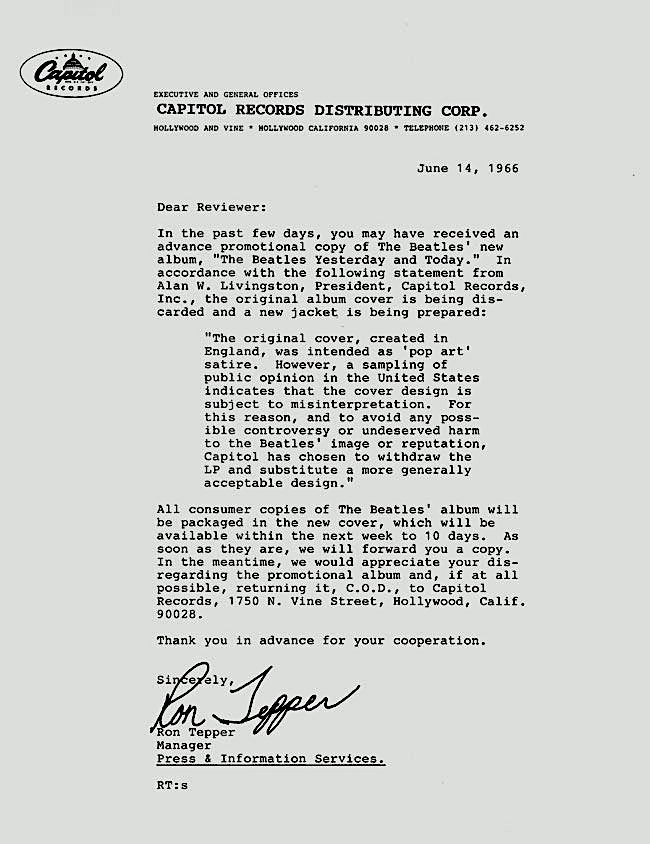
Many of the Butcher covers were destroyed by Capitol but an enterprising employee realized that a new cover image could be glued over the old cover image. So a couple hundred thousand made their way to Capitol pressing plants in Scranton PA and Los Angeles where a new cover slick was pasted over the Butcher cover image. This “paste-over” saved Capitol about 10 cents per sleeve. Still, Operation Retrieval costs Capitol Records around a quarter of a million dollars, an unheard of sum back in 1966, and the first time an album cover had been recalled due to their concerns about a negative public reaction.
Why did the Beatles allow this LP to get released? Brian Epstein, their manager, said the band did it as their commentary on war. Given the images coming across television screens and newspapers from the US war in Vietnam and the British conflicts in Aden, Malaysia and Northern Ireland, it was no wonder that the Beatles were beginning to understand the power that they had in communicating their opinions via their art.
AS A COLLECTOR, HOW DO I FIND ONE?
Over the years, I’ve found 2 MONO Butcher Covers for $1 each. Shocking, yes, but easier than you might think! I’ll give you a few tips in a minute on how you might be able to find one. But first, let’s identify what we’re looking for and their value.
There are 3 types of Butcher Covers:
FIRST STATE BUTCHER COVERS
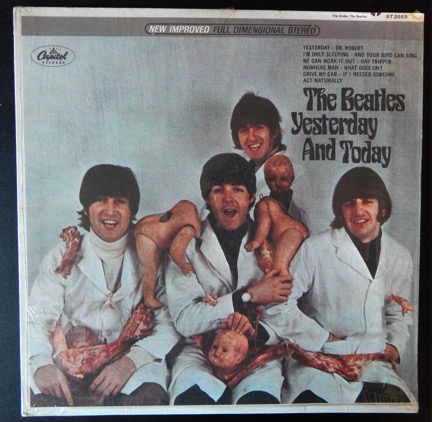
- FIRST STATE BUTCHER COVERS are copies that are in their “first state” and have never been “pasted over”. As you might imagine, there are not too many of these around. The rarest Butchers are these first state copies and the most rare come from the collection of…wait for it…ALAN LIVINGSTON, the President of Capitol Records. Yes, the same guy who said that any employee caught stealing one of these would be fired. Alan had 4 SEALED Stereo Copies and 20 SEALED Mono Copies delivered to his home where they sat for 20 years in his closet. His son Peter, in 1986, went to the Beatlefest in Los Angeles, and sold a Stereo copy for $3000 and a couple MONO copies for $1000 each. More recently, a SEALED Near Mint STEREO Livingston Butcher (as they are now called), sold at auction for $125,000 dollars, making it one of the most valuable records of all time. Prices range on these as the Monos outnumber the Stereos, most believe at a ratio of 5:1. For a Very Good+ first pressing, which is a pressing with a clean cover, lightly handled, with a good spine and seams, I would expect to pay around $5000.
SECOND STATE BUTCHER COVERS
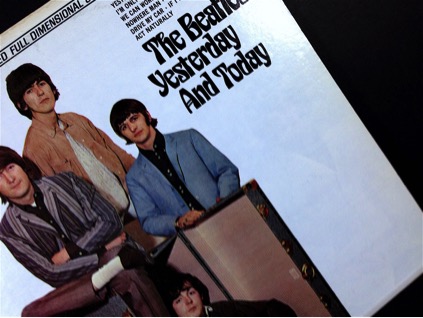
- SECOND STATE BUTCHER COVERS are the copies that have been “pasted over” with the revised cover showing a very large steamer trunk with some very bored looking Beatles. If you look thru the revised cover’s white background, at an area between the top of the trunk and the opening of the sleeve, you can make out the outline of Ringo’s black turtleneck sweater under his white Butcher smock. This is the kind of Butcher that I have found twice; one time in a collection that I bought and, once, in a dollar bin at a local shop. Oddly, Second State Butchers have become more rare as more people attempt to peel the top cover off! Obviously the rarest would be a Sealed Stereo Second State Butcher which, I believe, could set you back, perhaps, as much as $20,000. There are a lot of VG to VG+ copies around; the VG covers could have a little writing on them or a broken seam or spine or some paper loss. The MONOs bring around $300 to $600, the STEREOs, $600 to $900. A good score would be to get one for a few hundred.
THIRD STATE BUTCHER COVERS
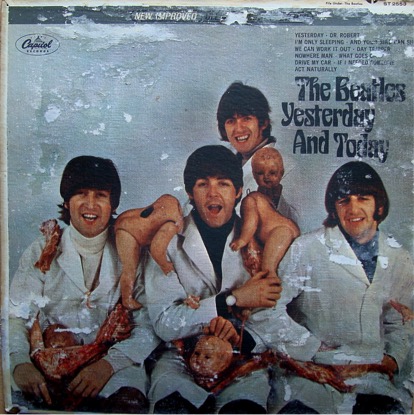
- THIRD STATE BUTCHER COVERS are the ones in which people have attempted to remove the top cover image to get to the Butcher cover image underneath. Quite often, the process is botched and the results show a mishmash of both images and the cardboard underneath. Even a bad peel job has value. First, you can say that you have one! Second, these are still collectable and a successful peel job can yield a beautiful result. Here’s a tip. If you’re going to attempt to peel a butcher, look for copies with a “2” or a “3” on the lower part of the back cover. This number identifies the manufacturing plant as the Capitol pressing plant in Scranton, PA. At that plant, they used a water soluble glue to adhere the new cover so removing the cover, with the right chemicals can be a potentially more successful project. Depending on how bad the peel job is, really determines the value. A really bad peel job may make a MONO sleeve worth less than $50. A good peel job with no tears and no obvious glue or chemical stains, could fetch up to $1000 for a MONO, $1800-2000 for a STEREO.
TIPS ON HOW TO FIND A BUTCHER COVER
Perhaps in a future blog, I can try that very PEELING process…all I need is your Butcher cover to experiment on….anyone game?
Lastly, those tips on where to find one. Obviously, if you buy record collections, you’re most likely to find one in a 60’s collection. Another fun place to look is at Garage & Rummage Sales, Junk or Antique Shops, and Flea Markets or other Public Sales. Often, they’re beat up…so if you’re gonna try to do a PEEL, look for that Scranton pressing with the number “2” or “3” on the back and most importantly, be safe and use proper safety equipment!
That’s all from Vinylvana so thanks for reading this!
For more cool information from Vinylvana, please subscribe to our YouTube channel! Also, Please visit our Vinylvana store on Discogs or Reverb to find the rarest releases from the artists that you love:
Our Discogs store is rutlandrecords: https://www.discogs.com/seller/rutlandrecords/profile
Vinylvana on Reverb: https://lp.reverb.com/shops/rutlandrecords/listings
Also, feel free to contact us directly via our Facebook or Instagram pages if you have records that you’re searching for or if you need help in developing your Vinyl collection! You’ll find a link to those sites here on this page. And of course, let us know your thoughts, ideas other subjects that you’d like to hear about in our videos.
